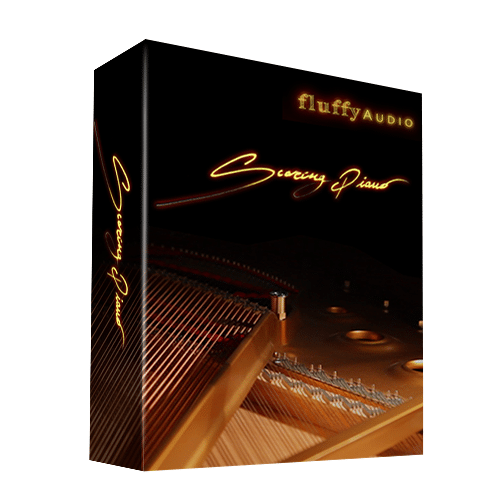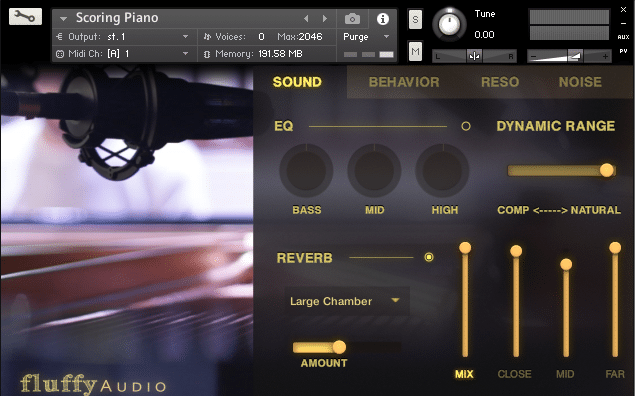Listen
In July 2016, we hit the road again, heading to Tuscany – our destination of choice.
What does a piano mean to us? What do we love about it? It’s the black bench, the resistance of the keys under our fingers, the soft noise of the hammer hitting the piano wire, and the clear, round, and airy sound that fills the space. There’s something moving, resonating, and vibrating about it. We wanted to do more than just sample a piano; we aimed to capture our own unique idea of its sound.
To make our project stimulating and enjoyable, we opted for an incredible studio – a tranquil place nestled in the countryside, a short drive away from one of the most inspiring and beloved Italian cities, Florence. The “Officina Sonora del Bigallo” or the “Bigallo Sound Workshop” perfectly blends innovative technology with traditional architecture, all within a picturesque landscape. It was once a farmhouse surrounded by olive trees, now located on the slopes of the Tuscan hills in Bagno a Ripoli, merely ten kilometers away from the city center.
On that morning, we met Aurelio, the chief manager of the studio, and Lawrence, the resident audio engineer and producer, at the entrance. After a brief overview, we quickly settled into our rooms, eager to begin our work. And so, the notes began to flow.
With the red light on in the studio, Pietro and Chiara arrived. Coffee time! The hard work flew by, and today, Pietro captured sketches of the countryside and Florence, as well as documented the recording setup, the gear, and even the piano bench. Meanwhile, Aurelio cooked pasta al pesto for us and shared his experiences in yoga, revealing himself to be a very open-minded person with an interesting life. The first day passed in true Italian style.
As the sunlight broke into the room, its slanted rays created a beautiful Tyndall effect, casting a timid glow through the window shutters. Tiny specks of dust danced in the air like a chaotic swarm of notes on a piano roll. I couldn’t help but wonder if we could sample them somehow – perhaps they’d make a sound too!
After breakfast and a quick briefing, we delved back into the notes – one after another. The time passed quickly, and soon it was lunchtime. Driving through the enchanting green hills of Tuscany, surrounded by cypresses, roses, prickly pears, and olive trees, we enjoyed local dishes like “pappa al pomodoro” and “fiorentina” steak.
Back in the studio, we continued our work, or rather, our play, for another couple of hours. The notes filled the air, and I felt like a piece of that floating dust, lost in the haze of a pitch meditation. How long could I stay in this studio, just playing the piano, key by key?
Several months have passed, but the mood of those sampling days still echoes in our everyday lives. Now, we can say that the “real” work begins. If we had a desk with tools, it would be a mess of cutters, markers, scores, glues, and addresses. I can even picture the distinct circle-shaped stain left by a coffee cup on a piece of paper, just beneath a photo book of Tuscany.
Finally, we have developed a beta version of the piano, ready to be tested. And who better to be the first tester than Riccardo Barba, a lifelong friend and experienced jazz pianist? We thought it was only fitting to reach out to Pietro and Racoon Studio once again, to create a video showcasing our work, attempting to convey even a faint idea of the emotions and ambiance of those days. Images of the studio and the piano naturally blend with the modest surroundings of the recording stage and the gentle nature that envelops the studio.
At last, Scoring Piano is ready.

This instrument will find a perfect spot for any kind of soundtrack and, like My Piano, for jazz and classical music. We have tried to take the softest dynamics particularly into account. Moreover, thanks to our Dynamic Range Control, it is very easy to achieve that “Thomas Newman” cinematic sound. In addition to this, Scoring Piano features a great dynamic range, enabling you to play any kind of music genres.
Our new instrument features lots of sound crafting controls, EQ, Reverb, three mixable mic positions and controls for pedal resonances and noises. We have avoided to include fancy effects, like delay, compressor and so on. Not only the quality of these effects in Kontakt is up to debate but also we have simply aimed at a great natural sounding piano.
Sympathetic Resonances
When you strike a single note with the damper pedal down, you hear a richer sound. This is the sympathetic resonance of all strings having some harmonics in common with the note you have pressed. This happens also when playing without pedal. If some notes are already down and some overtones are in common with the new note, they will resonate. These complex interactions are essential to a stunning lively piano sound.
Self Masking
In many libraries, when repeating a note with the pedal down, sustains usually build up, thus increasing polyphony dramatically. This taxes CPU and disk streaming and it can also lead to sound inconsistencies, like phasing, and a noticeable noise floor rise.
Our system compares each note with the previous one on the same key and determines which is the loudest. This is not a simple problem as the decaying part of a loudest note can be softer than the attack of a softer note. After the script compares the two notes, it discards the lowest by slowly fading it.
Mic Positions
The instrument features three mic positions: Close, Mid and Far. Close microphones are our favourite, with their peculiar dark sound. Mid microphones are terrific in combination with Far mics. The latter contribute to a sense of space for the whole mix.
For these reasons, it sounded natural for us to add a fourth Mix position: 100% Close, 50% Mid and 70% Far mics.
Full version of Native Instruments Kontakt 5.5 or above is required
NOT COMPATIBLE WITH KONTAKT PLAYER
Windows XP / Vista / 7. Intelmac and Mac OS 10.5 or higher.
4 GB System Ram, 5 GB free on HD
For Scoring Piano, we’ve refined our work with the sample masking technique, that fades old notes sustained over the same key: this helps to prevent phasing issues common to standard piano libraries and to control the polyphony.
This strict control over polyphony allowed us to implement an emulation of the interaction between keys that is evident on every piano. If a key is held pressed while another one is struck, you’ll hear a third pitch that is the result of the interaction of the first two. This is called Sympathetic Resonance and the result is a warmer piano sound, very suited to soundtracks and delicate, intimate piano works.
More info
FEATURES
- 6578 Samples
- 8 included NKI presets
- 20 GB installed (compressed with in NCW format)
- Sampled with Schoeps and AudioTechnica Mics and Millennia Media preamps
- Three Mic Positions (Close, Mid, Far) + Mix Position
- 24 bit / 48 kHz stereo
- From 7 up to 40 velocity layers per key (average 15 velocity layers per note)
- Sympathetic Resonances and Pedal Resonances control for maximum control over instrument warmth
- Release Samples
- Equalizer, Dynamic Control and Convolution Reverb
- Complete control over velocity response
- Self Masking for polyphony control
- Separate pedal down resonances and pedal noise control
- Nice occasional crackles knob to emulate the realism of a live recording












